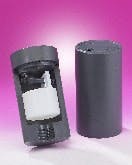Plast-O-Matic Valves, Inc. has developed an all-thermoplastic, automatic continuous degassing Valve.
Series DGV was developed specifically for corrosive applications subject to outgassing, such as sodium hypochlorite, hydrochloric acid, and ozone systems. The normally-open valve has an internal float that pivots an arm and seal assembly as it rises and falls. When liquid fills the system, the float rises and the valve closes. As air or gas accumulates in the valve, it displaces liquid and allows the float to fall, re-opening the valve and releasing the gas. The process repeats over and over as gas occurs.
A unique assembly of o-rings is used to energize the arm and control the pivoting action. This patent-pending design is what gives Series DGV the capability to open repeatedly, yet seal bubble-tight as soon as liquid is present.
When designing the piping system, it is essential that the Degassing Valve be installed at high points in the pipeline. As outgassing occurs, it usually accumulates at the highest points in the pipeline. A DGV installed elsewhere in the pipeline will not likely be effective, because it doesn't "catch" air as it passes by. It is also essential that the liquid process have a specific gravity of .9 or higher, otherwise the float won't float.
The DGV has a ½" NPT process connection, and a 1/8" NPT outlet. Because small amounts of liquid ? and certainly vapor ? may be expelled, the outlet should be piped to a scrubber or other safe area when used in potentially hazardous applications.
Valve body materials are offered in Geon PVC or Corzan CPVC, with EPDM or FKM (Viton) seals. The float is manufactured of natural polypropylene.





